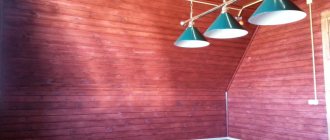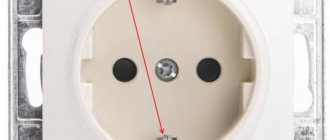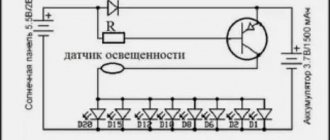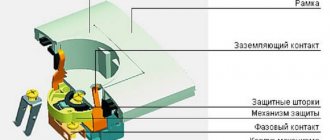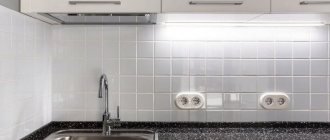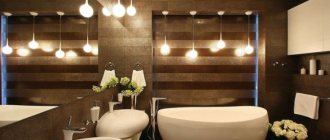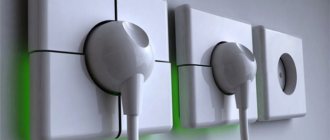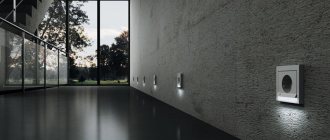Is it possible to install a socket in the bathroom?
In buildings built back in Soviet times, there was almost no provision for installing sockets in bathrooms. The main reason was weak wiring, small area of premises, lack of electrical appliances that required connection. All available switching means - sockets and switches - were installed outside, not far from the door.
This connection scheme created certain inconveniences, since all electrical appliances had to be connected from the outside, and the door to the bathroom did not close. Many owners were forced to use extension cords, which is strictly prohibited by the requirements and provisions of the PUE.
Modern apartments are distinguished by large areas for furniture and a bathroom, especially where the bathroom is combined with a toilet. Additional internal space has appeared, where, in addition to small household appliances, it is possible to place powerful equipment - washing machines, boilers, heated towel rails and other types of electrical installations. Many rooms are equipped with underfloor heating systems that require a separate connection.
Before installing sockets in the bathroom, you should determine their exact number, in accordance with the planned connection of consumers. Among them, a division should be made into equipment that is constantly connected to the network and devices that are used only occasionally. Devices that are constantly connected to the network can be connected not to an outlet, but through a terminal block directly to the home electrical panel.
Areas for installing sockets
- 0 – red zone. This includes the sink, the inside of the bathtub, and the shower stall. It is prohibited to install sockets here.
- 1 – area under the sink and on top of the bathtub. Installing 220 V outputs is also prohibited here. However, connection via a machine is allowed. Therefore, boilers in the bathroom are usually not plugged in.
- 2 – space at a distance of 60 cm around the sink, bathtub, shower , where humidity is high and there is the possibility of direct contact with water. Installation of connection points is prohibited, but it is allowed to install appliances that are turned on through an outlet: washing machine, lamps, boiler.
- 3 – remaining space . 220 V outputs are officially allowed to be installed only here. In this case, the degree of protection must be at least IP44.
The described sectors exist with a partition height of 225 cm. Everything above is completely free from prohibitions. A washing machine or boiler can be connected through sockets if they are mounted at a distance of 15–20 cm from the ceiling.
If the bathroom is small and there is no zone 3, it is better to move the connection points outside.
Dividing the room into separate zones
When choosing an installation location, you must follow the rules and be guided by the PUE, and all distances must be observed, including the installation height of sockets. It is recommended to arrange the sockets in such a way that in the event of a breakdown, they have easy access for replacement or repair. To avoid violations of installation rules, the entire bathroom room is conditionally divided into several zones.
According to regulatory documents, the entire territory of the bathroom is conditionally divided into several zones. They determine the degree of safety and allow you to most optimally develop a plan for the placement of electrical appliances and equipment, laying wiring to each point in the shortest possible way.
The conditional division of the bathroom includes the following zones:
- Zone 0: Covers the inside of the shower tray and the inside of the bathtub. It is not possible to place any waterproof electrical equipment in this location.
- Zone 1. Located directly above the shower tray, bathtub, washbasin or sink, at a height of 2.5 m from the floor level.
- Zone 2. Located up to 60 cm in all horizontal directions from cabinets, shower tray, bathtub or sink. The height from the floor is up to 2.25 m. It covers the area above the 1st zone at a height of 3 m from the floor.
- Zone 3. Overlaps the 2nd zone by 2.4 m, maintaining a height from the floor of 2.25 m. The height above the 2nd zone is up to 3 m. Based on these parameters, the height of the sockets in the bathroom is determined.
Additional requirements
The socket should not be too close to the gas pipeline. It must be carried out at a distance of 50 centimeters or more. Even better, if a person touches a metal object, there is no way they can reach the outlet.
In addition, the new device should be convenient to use. When connecting any cord, you should not bend or bend in any way. Everything must be installed in such a way that there are no obstacles in the way.
That is why all home craftsmen should know how to connect an outlet in a bathroom with their own hands in an open area. If a washing machine or some furniture interferes with installation, then you need to think in advance about other places for convenient connection and disconnection of the plug.
Where are sockets allowed?
After the bathroom room is conditionally divided into several zones, you can calculate how many sockets there should be and choose a place to place sockets for electrical equipment. At the same time, you must comply with the rules and regulations established for each site.
The zero zone, as already noted, is not intended for the installation of any devices. The exception is devices used directly in the bath. They operate on a voltage no higher than 12 V, and the placement of supply step-down transformers is carried out outside the boundaries of this area.
In the first zone you can install a shower and an instantaneous water heater. It is also possible to install an individual electric shower equipped with a pump with high-quality waterproofing. The wires connecting these devices also pass here.
In zone 2, the location of all devices permitted in zone 1 is allowed. In the same area, lighting and water heating devices with a protection class of at least 2, equipped with basic and additional insulation, are installed. In all listed zones, from 0 to 2, distribution boxes and controls are prohibited.
The third zone is considered the most remote from dangerous places. Firstly, they must be connected through an RCD with an operating current of up to 30 mA. If a group line is used, the trigger current is set to 10 mA. The second condition or option is to connect sockets using an isolation transformer, but in practice this method is used very rarely. The distance from the socket to the pipeline must be at least 50 cm, and from the shower door - 60 cm or more.
Choosing sockets for the bathroom
Choosing suitable waterproof sockets for the bathroom is not difficult at all. Despite the large number of design solutions, from a technical point of view these products cannot be classified as diverse. When classifying them, only two main characteristics are used - power and the number of consumers connected simultaneously.
The quantitative indicator, as a rule, does not raise any special questions. When choosing sockets, the main attention is paid to the power rating. For example, washing machines and other powerful equipment are connected to outlets rated at 16 A. Devices with lower ratings may melt due to overload and cause a short circuit. Low-power sockets, including those with a cover, are used to connect hair dryers, electric shavers and other similar devices, for which a rating of 8 A is sufficient.
The main difference between products intended for bathrooms is their protection from moisture and the presence of a spring-loaded lid that protects against direct water ingress. All distinctive features are indicated in the markings applied to the housing and include IP symbols with two numbers.
The digital designation characterizes the ability to counter various types of external penetrations. The first number corresponds to the class of protection against dust, and the second – against moisture. The degree of moisture protection is indicated by numbers from 0 to 8. The lowest is class zero, and the highest is class 8, in which the product can be used while completely immersed in water to a depth of over 1 m. In bathrooms, it is recommended to use sockets with protection class 4 and above, providing protection against drops and splashes in all directions.
It is also possible to install sockets with a lower degree of protection. However, such products cannot be installed openly. They must be installed in a special protective casing with the necessary tightness. In addition, any outlet intended for the bathroom must be equipped with a grounding contact.
Laying a line to the bathroom
Wet walls and floors in rooms with high humidity create an environment that conducts electricity well. Therefore, laying wires in the bathroom should be done according to certain rules:
- The wires are laid in a hidden way, under the trim in a corrugated pipe.
- Indoor installation of distribution boxes, various twists and connections is prohibited. The wires are laid in one piece and pulled from the box installed outside.
- Determining how many sockets are needed - most often, no more than 2-3 pieces.
- There should be a separate outlet in the bathroom for the automatic washing machine and water heater. The switch is installed outside the premises.
- Each group of devices or dedicated line is equipped with a circuit breaker.
- Wiring lines should be drawn strictly vertically and horizontally, at what height is required in specific places. The wires themselves must have copper conductors with a cross-section of at least 2.5 mm2, triple insulated. Wires that have been used, with a large number of bends or with damaged insulation are not allowed to be used.
It is recommended to replace old wiring that was installed a long time ago and has never been changed. This will allow during operation to avoid such malfunctions as overheating, short circuits, sparking, fire, accompanied by constant tripping of the circuit breaker. Often you have to solve the problem of how to move an outlet.
After marking the lines, wires and cables are laid in place. The gasket can be made in the voids between the wall and the decorative covering using corrugated sleeves. In the second option, the wires are laid directly in the walls, for which grooves are made in advance according to markings. After laying, the wires are fixed with staples, and then the grooves are covered with a solution of building plaster.
Next, in the places where the sockets are installed, socket boxes are mounted, secured with alabaster. They contain wires with three cores, two of which are phase and neutral, and one is ground.
Wire selection
The wiring is mounted using a three-core cable with improved insulation. All conductors have their own color to make it easier to connect everything. Blue – zero, brown – phase, green-yellow – ground.
It is best to buy a copper cable. It has many advantages over aluminum: improved flexibility characteristics, does not oxidize as quickly, can withstand increased loads, and not such strong contact resistance when connected to a machine and socket.
The only thing is that you need to cover all the mounting ends with solder. Then the connection will be reliable. The single-wire version does not require such an operation, but it is much tougher than the three-wire one.
Ensuring safe operation
One of the elements of electrical safety is a protective grounding device - RCD. Previously, when two-wire wiring was used, a separate large-section cable was brought from the bathroom to the distribution board and connected to the grounding bus. Thus, the question of how to make grounding was resolved. Modern wires initially have three wires, one of which serves as a grounding wire. It should be connected to the ground terminal of the waterproof socket and then also goes to the distribution board.
Additional electrical safety is provided by a residual current device. These devices are required for use in electrical wiring lines leading into bathrooms. The RCD is located in the home electrical panel and cuts off the power in the event of current leaks.
A separate RCD with a rating higher than the rated current of the circuit breaker is installed on the sockets in the bathroom. If this condition is not met, then the circuit with the protective device simply will not function normally.
Simultaneously with the RCD, automatic circuit breakers are installed to protect the line from overloads and short circuits. They protect individual outlets dedicated to high-power appliances or groups of outlets. The rating of the protective equipment is selected in accordance with the expected load.
Effect of condensation
In addition to splashes in bathrooms, there is another serious problem - condensation. The influence of this factor is less noticeable than direct splashes, but it is also very dangerous, especially if the outlet is located near a water source. This could be an outlet for an electronic toilet lid or for a hydromassage shower.
Condensation accumulates in such places constantly, and it is almost impossible to eliminate its influence using conventional ventilation. This is another reason to choose sockets with the maximum level of protection in the zero and first zones.
The requirement for the installation height of sockets in the bathroom is also related to the influence of moisture that accumulates on the walls. The lower the outlet is, the more moisture will enter the device as moisture flows down.
This requirement is also not always easy to comply with; in this case, it is also worth giving preference to devices with the most reliable protection against moisture.
You should not solve the problem of power supply in the bathroom using a household extension cord; exposure to moisture can lead to a short circuit and damage to the equipment.
You can partially reduce the effect of condensation on electrical appliances in the bathroom if you take into account the following circumstance: more moisture accumulates on those walls of the bathroom that border the entrance.
These walls are less well heated from the outside, and the temperature difference causes condensation. When thinking about the layout of the bathroom, you need to remember this fact.
